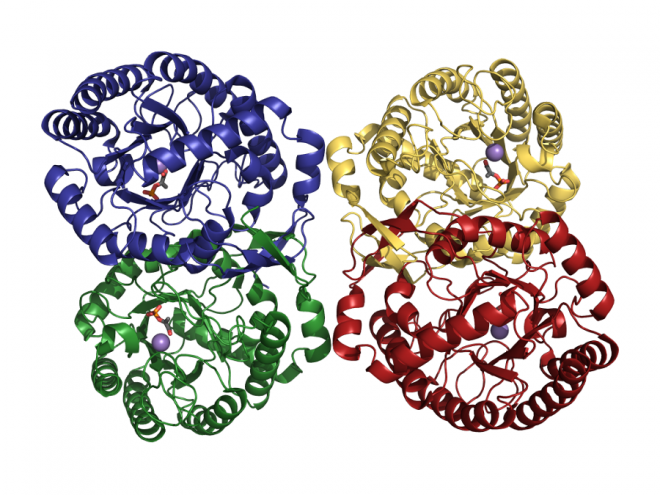Understanding biomolecular enzymes to develop new therapies
Professor Emily Parker from the University of Canterbury is leading a research programme into molecular understanding of the process behind allosteric regulation. While allosteric regulation is a well-known and important metabolic process, its precise mechanisms on a molecular level are still poorly understood. The aim of this work is to investigate the possibility of developing therapies that would interfere with a metabolic pathway that affects bacteria, but not humans.
Allosteric regulation is ubiquitous and crucial to metabolic control. By temporarily altering the catalytic efficiency of individual enzymes, allosteric activators and inhibitors can have profound effects on diverse cellular processes. Those processes include protein synthesis, movement, secretion of chemicals, communication with other nearby cells, division, and programmed death.
With support from the Marsden Fund and NeSI, Professor Parker’s research group has been able to carry out research that may lead to novel antibacterial and antifungal agents. A particular focus of their studies is the enzyme at the start of the “Shikimate pathway”. This important metabolic pathway is used by bacteria and many other organisms to synthesise a range of essential amino acids. The clinical significance of this pathway is that it is not used by animals.
The computational resources for modelling these molecules and their reactions over the timescales required to shed new light on the phenomenon are immense. Without access to high performance computing platforms, this research would be nearly impossible to conduct in New Zealand.
Roles of NeSI
In addition to raw computing hardware, NeSI employs highly trained scientists and technical experts. They work closely with the country’s scientists. In the case of Professor Parker’s group, Dr Ben Roberts has worked closely with PhD candidate Eric Lang on this project. The pair take some time to discuss how things have been going so far.
Eric begins by talking about how his work fits into the broader picture. “A few years ago, Wanting Jiao – who did her PhD in the group and who is now a postdoc – studied by molecular dynamics one of the member of this family of enzymes. Her work shed light on the allosteric regulation mechanism of this particular enzyme and backed up nicely some experimental results. We are thus trying to extend this approach to other member of this family, and this is the main focus of my PhD.“
HPC orientation and skills training for researchers
Getting started on NeSI’s HPC platforms has been a mix of peer-support, self-learning and structured training. “Wanting Jiao taught me how to set up the simulations and helped me to start my first simulations. I also learnt NAMD [software used for molecular dynamics] by doing some tutorials and reading the method section of several papers.”
“I have had the opportunity to attend the three courses on parallel computing organised by Bluefern, and that was incredibly useful. It allowed me to gain a better understanding of the concepts behind HPC and to gain hands on practice in writing my own parallel programs. It helped me to communicate more easily with the Bluefern team and NeSI by introducing me to the appropriate HPC vocabulary, being aware of the type of information needed for troubleshooting, and understanding the kind of problems that might arise in a HPC environment.”
Fit-for-purpose computing platforms
“In principle, Eric and Emily could have used a public cloud for their work, or they could have built a small cluster and run it locally,” says Ben, “but by running their simulations at NeSI, they gain a number of advantages.”
Ben adds, “They don’t have to worry about whether the machines they get are suitable for the task at hand. For example, their preferred application for running their simulations, NAMD, was already available on NeSI’s systems, and had been shown to perform well. And if it hadn’t been ready for them to use, we have five different high-performance clusters, each optimised to a different sort of work, so that the chances were very good that at least one of our systems would be fit for their particular workload.”
Fast, effective technical support
Researchers are able to access technical support via support.nesi.org.nz. The ticketing system is supported by staff nationally and receives over 99.9% satisfaction ratings.
I am really grateful for all his support and things wouldn’t have been working so smoothly without his help.
Eric discusses his experiences, “I have been working extensively with François Bissey, and before that with Céline Cattoën-Gilbert. He is often the person who installs the programs I need – which is usually not a trivial task – or troubleshoots the problems I might encounter on the BlueGene, POWER7 or visualisation cluster.”
“I am really grateful for all his support and things wouldn’t have been working so smoothly without his help. The same comments are also valid for Celine!”
Domain expertise
“They [researchers] also have access to highly skilled domain expertise,” supplements Ben. “How many cloud providers are likely to have a support person with eight years’ experience doing computational chemistry? I was able to meet with Emily and Eric in person, and to use my background knowledge to suggest software packages that might help them to achieve their research goals.”
“When they chose one, Amber, I spent time installing the most up-to-date version of Amber on the POWER 7 cluster in Christchurch. Solving compiler error messages may not sound particularly enthralling, but it’s actually very satisfying to know that I’ve helped a scientist to get his research done. And I don’t just help with computer stuff either. Eric has asked me for advice on how to set up his simulations to get the most scientific milage from them.”
“On one occasion, I helped him to choose between steered, targeted, and accelerated molecular dynamics. We eventually chose targeted because it looked like it would get him to the desired end state the most quickly while at the same time being sufficiently physically realistic.”
“On another occasion, I had a look over a simulation configuration he showed me. Now because of the way he represents the solvent, he has to use an approach called periodic boundary conditions, which creates lots of replicas of the original system repeating in all directions. It’s a bit like synchronised swimming, and just like in synchronised swimming, you usually don’t want to bump into your two neighbours. I was able to see the risk of this happening in Eric’s simulation, and I suggested a change that would greatly reduce that risk.”
Boosting nationally significant research
The work carried out by Emily Parker and her research group has been supported by the Marsden Fund. NeSI’s access policy provides provisions for enabling research that has progressed through peer-reviewed processes, such as the Marsden Fund, by providing an 80% subsidy and access to domain expertise.







